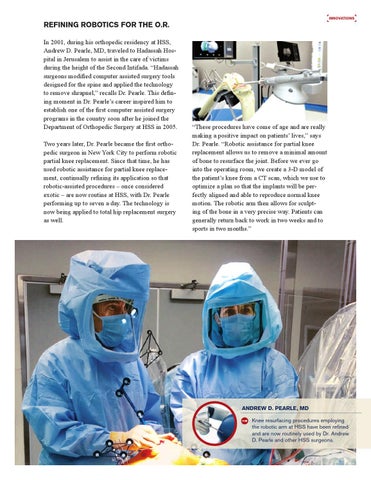INNOVATIONS
Refining Robotics for the O.R. In 2001, during his orthopedic residency at HSS, Andrew D. Pearle, MD, traveled to Hadassah Hospital in Jerusalem to assist in the care of victims during the height of the Second Intifada. “Hadassah surgeons modified computer assisted surgery tools designed for the spine and applied the technology to remove shrapnel,” recalls Dr. Pearle. This defining moment in Dr. Pearle’s career inspired him to establish one of the first computer assisted surgery programs in the country soon after he joined the Department of Orthopedic Surgery at HSS in 2005. Two years later, Dr. Pearle became the first orthopedic surgeon in New York City to perform robotic partial knee replacement. Since that time, he has used robotic assistance for partial knee replacement, continually refining its application so that robotic-assisted procedures – once considered exotic – are now routine at HSS, with Dr. Pearle performing up to seven a day. The technology is now being applied to total hip replacement surgery as well.
“These procedures have come of age and are really making a positive impact on patients’ lives,” says Dr. Pearle. “Robotic assistance for partial knee replacement allows us to remove a minimal amount of bone to resurface the joint. Before we ever go into the operating room, we create a 3-D model of the patient’s knee from a CT scan, which we use to optimize a plan so that the implants will be perfectly aligned and able to reproduce normal knee motion. The robotic arm then allows for sculpting of the bone in a very precise way. Patients can generally return back to work in two weeks and to sports in two months.”
Andrew D. PEARLE, MD Knee resurfacing procedures employing the robotic arm at HSS have been refined and are now routinely used by Dr. Andrew D. Pearle and other HSS surgeons. 11
